Mobile App User Acquisition: 5-Step Process for Success

Let’s be honest: paid mobile app user acquisition is a mess. And if you don’t agree with this, either you’re lying to yourself, or you’ve been frozen for the past three years and just woke up.
Table of Contents
- Mobile App User Acquisition: What Just Happened?
- A Holistic Approach: The Growth Rocket Model
- A Systematic Approach: The Paid UA Process
- Structured Activities for Each Paid UA Phase
- How to Use the Paid User Acquisition Procework
- Conclusion
Now, making a step back. Do you remember 2019? The duopoly, Facebook and Google, was dominating the advertising industry, both on mobile and desktop, with Apple Search Ads and TikTok that were considered emerging channels and Twitter and Snapchat as nice to have.
Google was tracking even the cookies you used to eat for breakfast, and the IDFAs were something we could use on a large scale—without any sort of limitation—to track users, retarget them, and profile them. It was the dream.
As a performance marketing manager, if you had a good budget to spend and knew a few optimization tricks on Facebook, it would have been relatively easy to scale user acquisition.
And then?
Mobile App User Acquisition: What Just Happened?
Then we had two main events that disrupted the advertising world: the tracking limitation introduced by Apple with iOS14 and the COVID-19 pandemic.
The two things indicated a series of consequences that are having a strong impact on the way we do marketing.
On one side, the tracking limitations have decreased the access to data, or better, the way we get data—we don’t have the immediate response we used to have when uploading a banner on Facebook (I remember optimizing creatives almost in real-time based on first clicks and installs).
Therefore, it became much more difficult to make quick decisions as we used to.
On the other hand, the Pandemic has urged many companies to move their business online. Just think about it. I’m sure your favorite family-run bakery now also sells products online. For this reason, we’re seeing increasingly fierce competition in online advertising, and in the specific—mobile.
We have a scenario where small advertisers are trying to fight the rising CPMs and big brands that are just burning millions of dollars of budgets because they just don’t care about the CPMs.
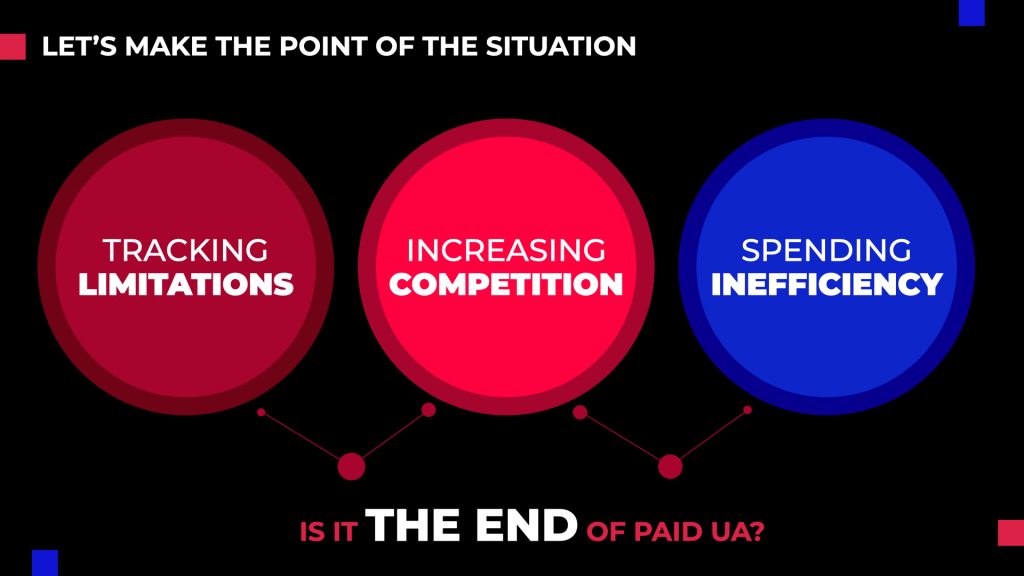

Mobile App User Acquisition: Is It the End?
All summed up, paid user acquisition risks to become more and more efficient, and the question that many ask themselves is: is paid user acquisition dead?
The answer to this questions can be two:
Yes, it is dead: if you still live in 2019, if you pretend that nothing happened and want to run performance marketing campaigns as if nothing happened, trying to read the data as it used before, using the same advertising channels, ignoring the experiments.
No, it is not dead: if you have decided to adapt to the changes and take them as an opportunity.
But what should we do then?
What Does Adapting Mean?
First of all, adapting means not behaving like this cute dog, pretending that everything is fine and that the advertising world isn’t burning out.
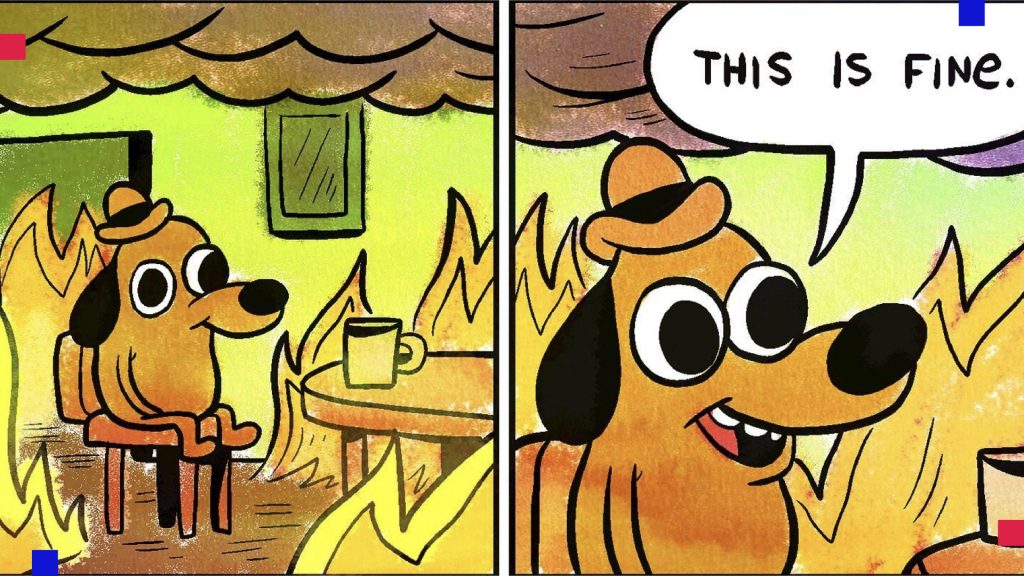

But most of all, adapting means changing the approach we have to paid mobile app user acquisition, firstly looking at it as part of a holistic marketing plan, secondly, following precise processes and frameworks that can help overcome the limitations related to data and targeting.
A Holistic Approach: The Growth Rocket Model
Already at the beginning of 2020, at REPLUG, we understood the urgency of rethinking the approach to paid user acquisition and app marketing in general. We decided to develop the Growth Rocket Model—based on the belief that app marketing success results from a holistic approach to growth activities.
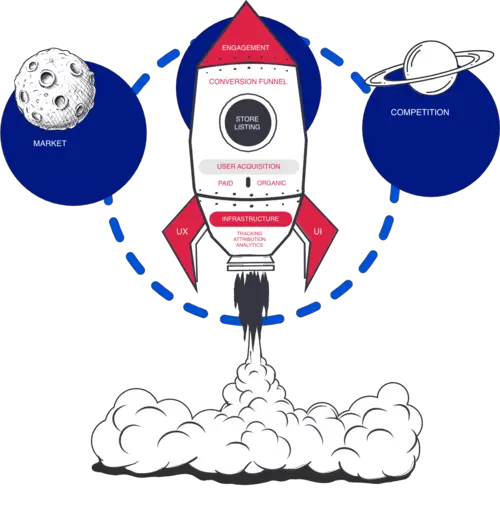

The GRM shows that Paid UA is just a part of App Growth—and, exactly like on a real rocket—it needs to work in cooperation with all the other components to guarantee a successful trip to space.
You can read how to apply the Growth Rocket Model in detail in this article.
A Systematic Approach: The Paid UA Process
Considering mobile app paid user acquisition as a part of a holistic plan alone is not enough. We should also start using a systematic approach that will allow us to identify challenges and opportunities clearly. At REPLUG, we’ve focused the majority of our projects—across different areas—on precise processes.
We have already discussed the 5-step CRM Process that helped us scale CRM activities for several clients, and in this article, we will discuss in detail our 5-step Paid UA Process. Moreover, we like to call it Procework—because we see it as a combination of a Process and a Framework.
Our Paid UA Procework is made of five actionable, consecutive phases. It is split into vertical phases and horizontal activities, and all the activities are grouped by type of activity: campaigns-related tasks, creatives-related tasks, and activities involving tech/cross area. Below is a new, updated version.
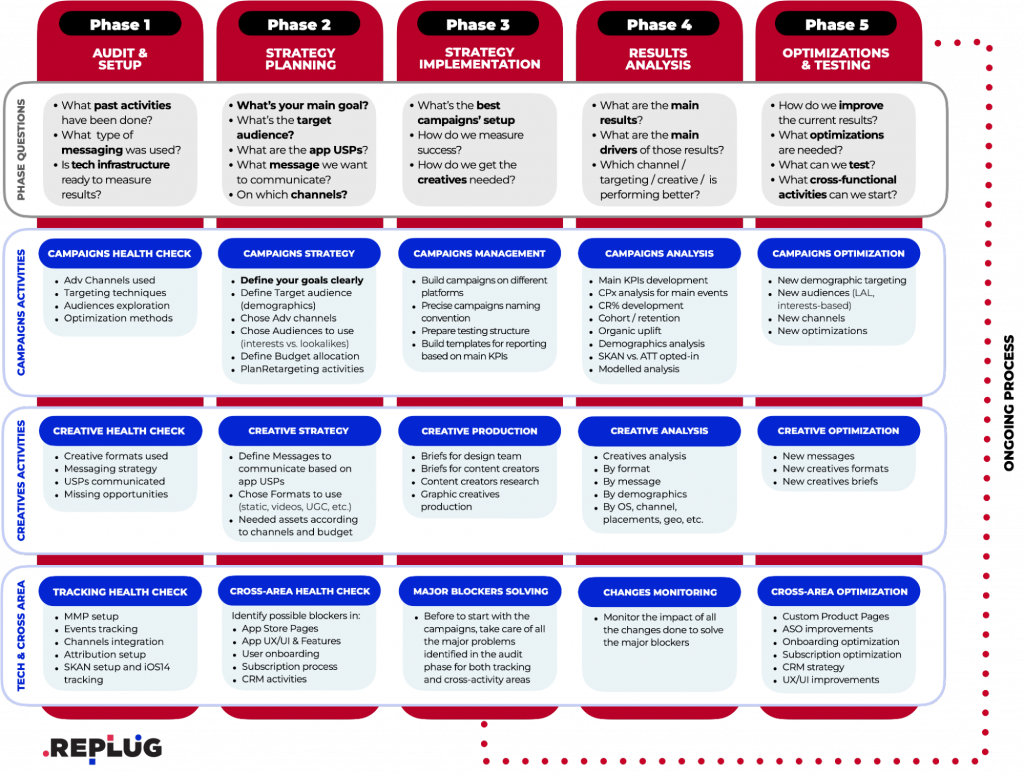

The new version of the framework
Want to learn how to scale your paid UA efforts and use our 5-step framework? Download our newest ebook today.
It’s important to note that the last three phases represent an ongoing process that we call the “Optimization Loop.”
Now, below, you can see the old version of the framework. Thanks to our day-to-day work and continuous optimization with different partners, we’ve been able to improve it and make a bulletproof playbook to scale paid UA. And, yes, our paid UA comprehensive playbook is coming soon!
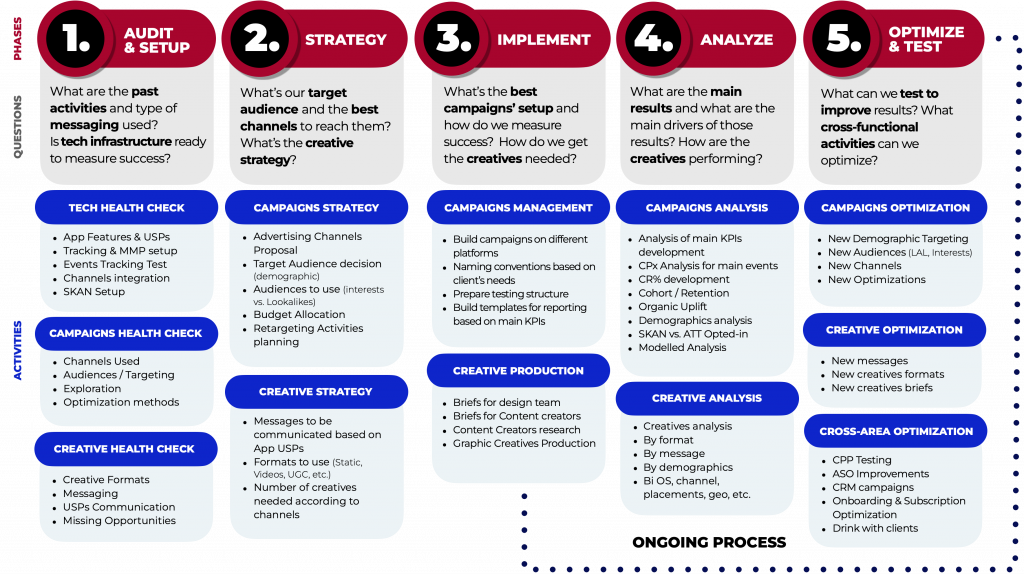

The old version of the framework
In the following paragraph, we will go into detail about each phase, identifying the specific questions connected to each of them.
5 Questions for Each Mobile App User Acquisition Phase
For each phase, we’ve developed a set of simple questions that are important to define what will be the focus of the phase and the activities that we need to go through.
Below you can see what the questions about each of the paid user acquisition processes are.
1. Audit and Setup
For each Paid UA project, this is the “golden phase.” When given a budget to spend, whatever the amount, it would not be very considerate to start immediately spending it without checking what past activities have been done and, most importantly, if we’re ready to measure success.
Questions to ask: what past activities have been done? What are the past activities and types of messaging used? Is tech infrastructure ready to measure success?
2. Strategy Planning
After the audit phase has been completed and we’ve got a clear understanding of the status quo, we need to go into the phase where we try to figure out the best way to spend our budget and achieve our goals.
Questions to ask: what is your main goal for the paid UA Activities? What’s our target audience, and what are the best channels to reach it? What’s the message to communicate and the creative strategy? What are the app USPs?
3. Strategy Implementation
Once the strategy is defined and approved, it’s time to implement the actual campaigns. That is a crucial phase because the accuracy of the campaign’s structure, for example, will define the ability to measure success and scale the paid user acquisition activities.
Questions to ask: what’s the best campaign setup, and how do we measure success? How do we get the creatives needed?
4. Results Analysis
Campaigns are finally live, we get the first data, and we start to analyze. This phase is crucial to understand what worked with the initial strategy and to start planning for the future.
Questions to ask: what are the main results and drivers of those results? How are the creatives performing? Which channel/targeting/creative is performing better?
5. Optimization and Testing
After getting the first results, it’s time to start optimizing to reach (even) better results. This is usually the most fun part because we have a lot to test in the mobile app paid user acquisition.
Questions to ask: what can we test to improve results? What cross-functional activities can we optimize? What kind of optimization is needed within the current activities? What new test can we do?


Of course, our work is not done by just asking ourselves a few questions. As we mentioned, some activities need to be performed, and they can be categorized under different areas that are usually constant across all the phases.
Structured Activities for Each Paid UA Phase
By asking ourselves the right questions, we can define the focus for each area and understand what type of activities we will need to perform. In this paragraph, we will go through such activities that, if followed, will increase the chances of reaching the goals.
As you see in the image below, our paid mobile app user acquisition includes a set of activities divided by area. Those areas are recurring for each phase.
The main areas of activities are:
- Tech: all activities related to the tech stack needed to run paid UA campaigns (MMP, analytics, etc.)
- Campaigns: all activities related to the strategy, management, and optimization of the campaigns across different ad platforms
- Creatives: all activities connected to the creative aspect of paid UA
- Cross-area: all the activities not directly connected to paid user acquisition but that can have a positive impact on results (e.g., App Store Optimization, Mobile CRM, etc.)
Now we will go through the different activities for each paid user acquisition phase.
Mobile App User Acquisition: Audit and Setup Phase Activities
The main activities of this phase, as the questions suggest, are related to health checks of current and past activities, and they’re divided into three areas:
1. Campaigns Health Check
Those are all the activities that are aimed at checking what kind of past activities have been running, which channels have been used, what types of targeting, optimizations, and others. All of these activities have the goal of identifying what kinds of previous activities have been carried out, which channels have been used, what types of targeting and optimizations have been performed, and their respective results.
2. Creatives Health Check
Because these activities are tied to the prior set, we can determine whether the various messages and creative types employed were sufficient and whether any chances were missed.
3. Tech Health Check
This box includes all the crucial activities to understand if we’re ready to run paid user acquisition from a tech point of view. During the tech health check, we usually go through the MMP setup to see if we can rely on the current tracking and attribution settings. We check the adv. channels integrations, the SKAN setup, and more.
The rule should be: if you can’t measure, don’t start spending.
Phase One Activities Output
At the end of this phase, you should have a firm grasp of the actual status. After going through all the processes, you should be able to tell whether you are ready to start with mobile app paid user acquisition immediately or need to change something.
You should have also identified the success levers that will serve as the foundation for your strategy.
Strategy Planning Phase Activities
The idea here is to say that the first step of the strategy phase should always be to define your paid UA general goal. What do you want to achieve with paid UA? With that in mind, you can take all the other decisions regarding strategy.
With the general goal in mind, we must ask ourselves about the main target audience, app USPs, channels, and more. Following that, we will again have a set of specific points for every activity in this particular phase.
1. Campaigns strategy: all actions related to paid campaigns are listed here, from the goals settings (as a preliminary point for the campaign’s strategy), channels we want to utilize at the start to the target audience (demographic, interests, look-a-like), budget allocation, retargeting requirements, and more.
2. Creative strategy: the actions linked to the planning of the creative part of paid user acquisition. We must decide what message to communicate and with what formats, how many assets we will require, and what app USPs we will want to communicate based on the channels we want to employ and target audience.
3. Cross-area health check: here, we can focus and check the key areas (App Store Pages, app features, app UI/UX, user onboarding, subscription process, and CRM activities) to make sure everything is going smoothly.
Phase Two Activities Output
The end of this phase should be a detailed plan for launching advertising and reaching your target demographic in the (presumably) most successful method possible. Please keep in mind that if we identified technical challenges during phase one, the initial portion of the strategy should be devoted to resolving those issues.
Strategy Implementation Phase Activities
When the plan has been created, approved, and finalized, it is time to move on to the actual campaign implementation. This phase is quite important since, for example, the accuracy of the naming structure of the campaign will determine whether or not it will be possible to monitor the success of the paid user acquisition activities and scale them.
1. Campaign management: this category contains all activities related to campaign development. We must pay attention to the money allocation and naming structure in this case. For instance, we appreciate a better setup for future analysis, testing structure, and reporting structure preparation depending on the KPIs we want to evaluate at REPLUG.
2. Creative production: these are various activities related to the development of graphic assets required to perform paid user acquisition campaigns. For example, we begin with briefs for our graphic designers to follow in order for them to create the materials.
3. Major blockers solving: before starting with the campaigns, take care of all the major problems identified in the audit phase for both tracking and cross-area activities. Those blockers might be regarding different areas within app marketing and UX/UI. For example, the App Store page might not be optimized and not clear, or the app might be missing some important features.
Remember, the main question in this case is: are there still any non-paid user acquisition-related major blockers that can prevent my campaigns from achieving the goals?
Phase Three Activities Output
We should be in a position to press the “start” button and begin spending money as soon as all of the tasks associated with this phase have been finished.
Results Analysis Phase Activities
The campaigns are now officially live. We have received the initial data, and analysis has begun. This phase is essential for understanding what aspects of the first strategy were successful and initiating the process of preparing for the future.
1. Campaign analysis: as previously said, this is a critical component of mobile app user acquisition and covers all operations connected to analyzing paid campaigns. Here, we attempt to investigate all of the factors that may be crucial in obtaining complete visibility and understanding how to get better results.
We clearly begin with the KPIs relevant to our primary goals and then expand our analysis to include everything else impacting those outcomes.
In addition to the basic cost per install and action, we look at the relative conversion rates. We do cohort analysis and see how organic traffic is performing and whether there is any increase. Furthermore, we attempt to find differences in performance for each demographic, age group, and other factors.
2. Creative analysis: The creative element also requires a thorough examination of the outputs. We must examine the various messages communicated, formats, placements, calls to action, and so on. These evaluations may also be performed by OS, channels, placements, gender, countries, age groups, and other relevant factors.
3. Changes monitoring: here, we should monitor the impact of all the changes done to solve the major blockers. With that being done, let’s focus on the results analysis output.
Phase Four Activities Output
By the end of this phase, we should have a clear understanding of how well the initial strategy worked, together with a transparent cost structure and an overview of conversion rates—by channel as well as by any other targeting aspect (audience, age, gender, country, and others).
Mobile App User Acquisition: Optimization and Testing Phase Activities
When the preliminary findings have been obtained, it is essential to begin optimizing in order to achieve (even) better outcomes. Because there is so much to try out in the mobile app paid user acquisition, this is typically the stage that brings the most excitement.
This is generally the most exciting and satisfying stage because we can “play” and explore through areas other than paid user acquisition. The actions in this area are separated into three main groups with the goal of improving outcomes.
1. Campaign optimization: all of these activities are aimed at discovering and testing new audiences (interest, look-a-like, retargeting, and more), new channels, new demographics, and optimization methodologies. There are (nearly) infinite things to try in terms of paid user acquisition channels nowadays.
2. Creative optimization: this group of tasks involves all optimizations and testing of new creative forms, messages, creators, and so on. We should have various things to test depending on the channels utilized.
3. Cross-area optimization: since we are checking all the areas that are not directly linked to paid user acquisition but still have the potential to impact the outcomes, these activities may create a difference in comparison to your competition. For example, in this group, we have the App Store Optimization activity, the Custom Product Pages test, and the onboarding optimization.
By aligning and combining cross-area strategies (which are almost endless), you can enhance user acquisition, improve app visibility, and provide a seamless user experience, ultimately leading to higher user engagement and better conversion rates.
Phase Five Activities Output
We should have a list of modifications based on the data acquired during phase four by the end of phase five. Then, we need that list to boost paid user acquisition spend efficiency. When we return to step three to implement the optimizations, the Optimization Loop may begin.
At this point, we should have a good understanding of the entire procedure. In the following part of this e-book, we will explain how the process works and how we should use it.
In the next paragraph, we will give you a better understanding of how the process works and how we should use it.
How to Use the Paid User Acquisition Procework
Our systematic approach to paid user acquisition can be applied across different mobile apps and different verticals—it doesn’t matter whether you are promoting a delivery app or a subscription-based fitness app, for example.
If you follow the steps for each phase, going through all the activities, chances are high that you will be able to achieve your goals.
Each phase depends on the previous one, with the audit phase always being the starting point.
Therefore, you must know if the tracking is in place before spending. You also need to know if you can learn something from previous activities or if there are major blockers in other areas of app marketing that could prevent you from achieving the goals.
If you note that the MMP is not correctly set up, you shouldn’t start spending. Moreover, if you see that the registration page is not optimized, for example, and your goal is to achieve registered users, you should try first to fix the UX problems.
Paid User Acquisition Procework: Next Steps
With the learning from phase one, creating a paid UA strategy to achieve your main goal will be easier. By understanding the main target audience, you’ll be able to decide which channels to use to reach it—at least in the beginning—and with which messages or creative formats.
The creative strategy is strictly connected to the channels we decide to focus on. For example, if you start using TikTok Ads, you will need different types of creatives rather than if you decided to start from Facebook Ads.
Once the strategy is approved, it is time to put it into place—usually, that’s why phases two and three go together, even if they’re two different phases.
Phase three—implementation—is crucial because if we ignore naming conventional budgeting and test structure, we won’t be able to scale and analyze. So it’s better to make a specific implementation plan and not stop at the strategic planning.
When you finally push the start button, it will be fun to analyze and optimize. Here again, we often combine phase four and phase five. It is due to the strict correlation between analysis and optimizations—we should base our tests on the results of past activities and iterate our best concepts both from a campaigning point of view and a creative standpoint.
Once we have planned our optimizations and tests—similarly to what we did in phase two—we go back to phase three and implement them, giving rise to the recurring process we call the “optimization loop.”
Conclusion
Viewing mobile app user acquisition as a standalone strategy is insufficient. We must also begin utilizing a systematic strategy that will enable us to identify difficulties and opportunities properly.
As we have seen throughout this article, it is all a matter of calculated planning, monitoring, testing, optimizing, and then doing the whole loop again. Which we call the magical “optimization loop”
Moreover, as we have mentioned, each phase is dependent on the one before it, with the audit stage always serving as the initial point.
Nevertheless, it may seem complicated at first, but it’s truly not. It’s just a matter of following the process and paying attention to details.
Are you interested in improving your Paid UA strategy? Get in touch with our team of experts and start growing your app today.
FAQ
What Is Meant by User Acquisition?
It is the process of acquiring new users for an app, platform, or another type of service. On mobile, user acquisition is a strategy centered on gaining installs, which is typically accomplished through advertising campaigns and special offers.
What Are the User Acquisition Strategies for Mobile Apps?
Paid social media marketing, owned media marketing, app store optimization, retargeting, and re-engagement campaigns are just a few of the most prevalent types of user acquisition processes.
What Is App User Acquisition?
App UA involves marketing a mobile app to attract new users. Paid advertising, organic traffic, and app store optimization (ASO) often drive app installs. The purpose of app user acquisition is to gain users for less than the average user’s lifetime value or average revenue per user.
Originally published on December 15, 2022. Updated on October 25, 2023.
Comments